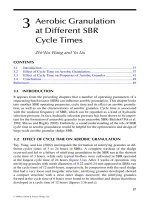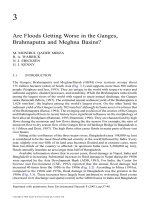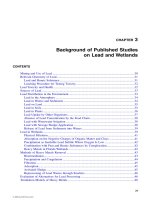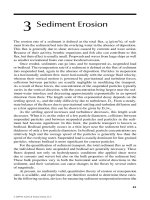Chapter 3: SOME MORE BASICS IN C++
Bạn đang xem bản rút gọn của tài liệu. Xem và tải ngay bản đầy đủ của tài liệu tại đây (251.14 KB, 30 trang )
Chapter 3
SOME MORE BASICS
Programming Fundamentals with C++
1
Outline
Assignment statement
Program input using the cin object
Formatting the output
Using mathematical library functions
Type Conversions
Octal and hexadecimal number
Block statement
Programming Fundamentals with C++
2
Overview
In the last chapter, we studied how result are
displayed and how numerical data are stored and
processed using variables and assignment
statements.
In this chapter, we study some C++’s additional
processing and input capabilities.
Programming Fundamentals with C++
3
Assignment
How do we place data items into variables?
Read in values typed at the keyboard by the user
Use an assignment statement
Assignment statement examples:
length = 25;
cMyCar = “Mercedes”;
sum = 3 + 7;
newtotal = 18.3*amount;
slope = (y2 – y1)/(x2 – x1);
Programming Fundamentals with C++
4
Assignment statement
Assignment operator (=) are used for assignment of a
value to a variable and for performing computations.
Assignment statement has the syntax:
variable = expression;
Expression is any combination of constants, variables,
and function calls that can be evaluated to yield a result.
Programming Fundamentals with C++
5
Assignment statement (cont.)
The order of events when the computer executes an
assignment statement is
- Evaluate the expression on the right hand side of the
assignment operator.
- Store the resultant value of the expression to the
variable on the left hand side of the assignment operator.
Note:
1. The equal sign here does not have the same
meaning as an equal sign in mathematics.
2. Each time a new value is stored in a variable, the
old one is overwritten.
Programming Fundamentals with C++
6
Assignment Variations
C++ includes other arithmetic operators in addition
to the equal sign.
Operator
Example
Meaning
--------------------------------------------------------------------------------=
iNum1 = iNum2
+=
iNum1 += iNum2
iNum1 = iNum1 + iNum2
-=
iNum1 -= iNum2
iNum1 = iNum1 - iNum2
*=
iNum1 *= iNum2
iNum1 = iNum1 * iNum2
/=
iNum1 /= iNum2
iNum1 = iNum1 / iNum2
%=
iNum1 %= iNum2
iNum1 = iNum1 % iNum2
sum += 10 is equivalent to sum = sum + 10
Programming Fundamentals with C++
8
Increment and decrement operators
For the special case in which a variable is either
increased or decreased by 1, C++ provides two
unary operators: increment operator and decrement
operator.
Operator
Description
--------------------------------------------------------------++
Increase an operand by a value of one
-Decrease an operand by a value of one
The increment (++) and decrement (--) unary
operators can be used as prefix or postfix operators
to increase or decrease value.
Programming Fundamentals with C++
9
Increment and decrement operators (cont.)
A prefix operator is placed before a variable and returns
the value of the operand after the operation is performed.
A postfix operator is placed after a variable and returns
the value of the operand before the operation is
performed.
Prefix and postfix operators have different effects when
used in a statement
b = ++a; // prefix way
will first increase the value of a to 6, and then assign that new
value to b. It is equivalent to
a = a +1; b = a;
Programming Fundamentals with C++
10
b = a++; // postfix way
will first assign the value of 5 to b, and then increase the value
of a to 6. It is equivalent to
b = a; a = a + 1;
The decrement operators are used in a similar way.
b = --a;
equivalent to
a = a -1; b = a;
b = a--;
equivalent to
b = a; a = a -1;
Programming Fundamentals with C++
11
Exercise on class
What are the results of the following program?
#include <iostream.h>
int main()
{
int c;
c = 5;
cout << c << endl;
cout << c++ << endl
cout << c << endl << endl;
c = 5;
cout << c << endl;
cout << ++c << endl;
cout << c << endl;
return 0;
}
Programming Fundamentals with C++
12
PROGRAM INPUT USING THE cin OBJECT
So far, our programs have been limited since that all their
data must be defined within the program source code.
We now learn how to write programs which enable data to be
entered via the keyboard, while the program is running.
Standard Input Stream
o The cin object reads in information from the keyboard via
the standard input stream.
o The extraction operator (>>) retrieves information from the
input stream.
o When the statement cin >> num1; is encountered, the
computer stops program execution and accepts data from
the keyboard. When a data item is typed, the cin object
stores the item into the variable listed after the >> operator.
Programming Fundamentals with C++
13
Example 3.4.1
#include <iostream.h>
int main()
{
float num1, num2, product;
cout << "Please type in a number: ";
cin >> num1;
cout << "Please type in another number: ";
cin >> num2;
product = num1 * num2;
cout << num1 << " times " << num2 << " is " << product << endl;
return 0;
}
The output of the above program:
Please type in a number: 30
Please type in another number: 0.05
30 times 0.05 is 1.5
Programming Fundamentals with C++
14
Exercise on class
Write a program that gets 3 numbers and prints out their
average
#include <iostream.h>
int main()
{
int num1, num2, num3;
float average=0;
cout << "Enter three integer numbers: ";
// Your code here
cout << "The average of the numbers is " << average << endl;
return 0;
}
The output of the your program should be:
Enter three integer numbers: 22 56 73
The average of the numbers: 50.333333
Programming Fundamentals with C++
15
FORMATTING FOR PROGRAM OUTPUT
Besides displaying correct results, a program should
present its results attractively with good formats.
Stream Manipulators
Stream manipulator functions are special stream
functions that change certain characteristics of the input
and output.
The main advantage of using manipulator functions is
they facilitate the formatting of the input and output
streams.
Programming Fundamentals with C++
16
Stream manipulator
setiosflags
This manipulator is used to control
different input and output settings.
setiosflag(ios::fixed) means the output field will use
convertion to a fixed-point decimal notation.
setiosflag(ios::showpoint) means the output field will
show the decimal point for floating point number.
setiosflag(ios::scientific) means the output field will use
exponential notation.
Note: Without the ios::fixed flag, a floating point number is
displayed with a default of 6 significiant digits. If the
integral part of the number requires more than 6 digits,
the display will be in exponential notation.
Programming Fundamentals with C++
17
Some other format flags for use with setiosflags()
Flag
Meaning
---------------------------------------------------------------------ios::showpos
ios::dec
ios::oct
ios::left
ios::right
ios::hex
display a leading + sign when the number is positive.
display in decimal format
display in octal format
left-justify output
right-justify output
display in hexadecimal format
To carry out the operations of these manipulators in a user
program, you must include the header file <iomanip.h>
Programming Fundamentals with C++
18
Example 3.2.2
// a progran to illustrate output conversions
#include <iostream.h>
#include <iomanip.h>
int main()
{
cout << "The decimal (base 10) value of 15 is " << 15 << endl
<< "The octal (base 8) value of 15 is "
<< setiosflags(ios::oct) << 15 << endl
<< "The hexadecimal (base 16) value of 15 is "
<< setiosflags(ios::hex) << 15 << endl;
return 0;
}
The output of the above program:
The decimal (base 10) value of 15 is 15
The octal (base 8) value of 15 is 17
The hexadecimal (base 16) value of 15 is f
Programming Fundamentals with C++
19
Stream Manipulators (cont’d)
setw()
The setw() stands for set width. This manipulator is
used to specify the minimum number of the character positions on
the output field a variable will consume.
setprecision() The setprecision() is used to control the number of
digits of an output stream display of a floating point value.
Setprecision(2) means 2 digits of precision to the right of the decimal
point.
Example:
cout << “|” << setw(10)
<< setioflags(ios::fixed)<< setprecision(3) << 25.67<<”|”;
cause the printout
|
25.670|
Programming Fundamentals with C++
20
²
Example 3.2.1
#include <iomanip.h>
int main()
{
cout << setw(3) << 6 << endl
<< setw(3) << 18 << endl
<< setw(3) << 124 << endl
<< "---\n"
<< (6+18+124) << endl;
return 0;
}
The output of the above program:
6
18
124
--148
Programming Fundamentals with C++
21
USING MATHEMATICAL LIBRARY FUNCTIONS
C++ provides standard library functions that can be included in
a program.
If your program uses mathematic function sqrt(), it should
have the preprocessor command #include<math.h> in the
beginning of the program.
Function Name
Description
Return Value
--------------------------------------------------------------------------------------------abs(a)
Absolute value
Same data type as argument
log(a)
Natural logarithm
double
sin(a)
sine of a (a in radians)
double
cos(a)
cosine of a (a in radians)
double
tan(a)
tangent of a (a in radians)
double
Programming Fundamentals with C++
23
Function Name
Description
Return Value
--------------------------------------------------------------------------------------------log10(a)
common log (base 10) of a
double
pow(a1,a2)
a1 raised to the a2 power
double
exp(a)
ea
double
sqrt(a)
square root of a
double
Except abs(a), they all take an argument of type double and return
a value of type double
Programming Fundamentals with C++
24
Example 3.3.1
#include <iostream.h>
#include <math.h>
int main()
{
int height;
double time;
height = 800;
time = sqrt(2 * height / 32.2); // gravitational constant g = 32.32
cout << "It will take " << time << " seconds to fall "
<< height << " feet." << endl;
return 0;
}
The output of the above program:
It will take 7.049074 seconds to fall 800 feet.
Programming Fundamentals with C++
25
Implicit Data Type Conversion
Note: Data type conversion can take place implicitly
across assignment operators, i.e., the value of the
expression on the right side is converted to the data
type of the variable to the left side.
For example, if temp is an integer variable, the
assignment temp = 25.89 causes the integer value 25
to be stored in the integer variable temp.
Programming Fundamentals with C++
27
Explicit Data Type Conversion: Casts
We have already seen the conversion of an
operand’s data type within mixed-mode expressions
and across assignment operators.
In addition to these implicit data type conversions,
C++ also provides for explicit user-specified type
conversion. This method is called casting.
Casting or type casting, copies the value contained
in a variable of one data type into a variable of
another data type.
Programming Fundamentals with C++
28









